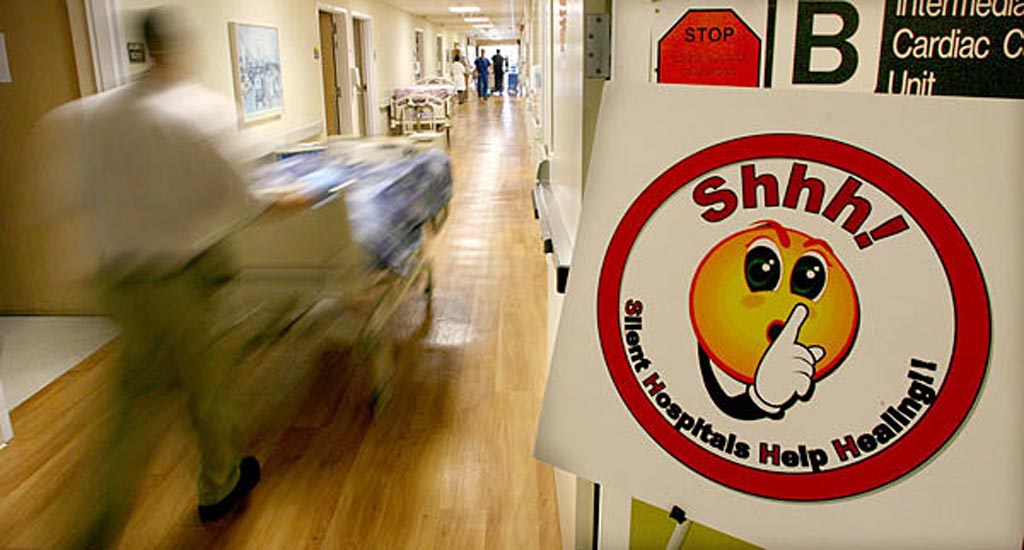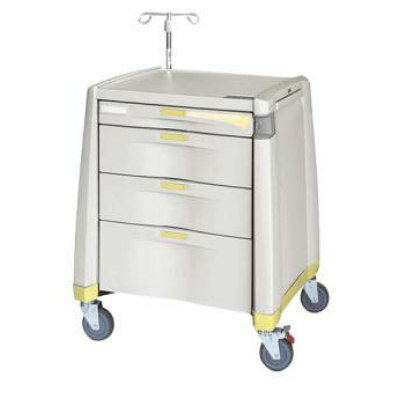Noisy Hospitals Face Threat of Decreased Federal Compensation
|
By HospiMedica International staff writers Posted on 19 Dec 2017 |

Image: Stanford is just one hospital trying to keep noise down (Photo courtesy of Stanford University).
A new review shows that hospitals in the United States are attempting different approaches to bring restful repose to their patients.
The new review, presented by BeoGrin Consulting (Baltimore, MD, USA), summarizes the limited number of studies currently available on hospital noise, and discusses the different approaches health care facilities are taking in order to address several issues raised by the U.S. Centers for Medicare & Medicaid Service (CMS, Baltimore, MD, USA) Hospital Consumer Assessment of Healthcare Providers and Systems (HCAHPS) survey, in which noise was claimed to be the top complaint of patients, staff, and visitors.
The constant beeps, whirrs, and alarms in a hospital can ascend to a cacophony that produces anything but a relaxing, restful environment. Noises can emanate from a variety of sources at the bedside or in the ward, including HVAC noise from required high air flows, equipment noise from machines such as MRI units, alarms from equipment at patient bedsides, pneumatic tube lab transport systems, and PA systems. Equipment alarms are the most egregious source, and although they are designed to alert staff of changes in the patient’s medical condition, many also sound when medication needs to be changed or when battery conditions are low.
One of the results of the HCAHPS survey is that hospitals are implementing noise control programs, which focus on two categories, engineering and administrative interventions. Engineering interventions aim to find ways to quiet the room, such as installing acoustical absorption materials along the walls and ceiling to dampen the noise level. Administrative interventions focus on changing behaviors, such as “quiet hours” when doors are closed and voices are kept low. The review was presented at the 174th Meeting of the Acoustical Society of America (ASA), held in December 2017, in New Orleans (LA, USA).
“In 2006, the federal government introduced HCAHPS as a standardized survey to measure patient perception of the quality of care received. The lowest score received by US hospitals in aggregate was the single acoustics question, which asks whether patients found their room sufficiently quiet to allow for sleep at night,” said review presenter Ilene Busch-Vishniac, PhD, of BeoGrin Consulting. “Faced with a loss of money, many hospitals are looking for ways to address noise levels in a way that patients can see as an improvement.”
One of the biggest changes in hospitals during the past 10 years has been to shift patient alarms from solely sounding at the patient’s bedside to also alerting a central monitor at a nursing station. This approach improves the ability of staff to identify and respond to alarms set at a reduced volume.
Related Links:
BeoGrin Consulting
U.S. Centers for Medicare & Medicaid Service
The new review, presented by BeoGrin Consulting (Baltimore, MD, USA), summarizes the limited number of studies currently available on hospital noise, and discusses the different approaches health care facilities are taking in order to address several issues raised by the U.S. Centers for Medicare & Medicaid Service (CMS, Baltimore, MD, USA) Hospital Consumer Assessment of Healthcare Providers and Systems (HCAHPS) survey, in which noise was claimed to be the top complaint of patients, staff, and visitors.
The constant beeps, whirrs, and alarms in a hospital can ascend to a cacophony that produces anything but a relaxing, restful environment. Noises can emanate from a variety of sources at the bedside or in the ward, including HVAC noise from required high air flows, equipment noise from machines such as MRI units, alarms from equipment at patient bedsides, pneumatic tube lab transport systems, and PA systems. Equipment alarms are the most egregious source, and although they are designed to alert staff of changes in the patient’s medical condition, many also sound when medication needs to be changed or when battery conditions are low.
One of the results of the HCAHPS survey is that hospitals are implementing noise control programs, which focus on two categories, engineering and administrative interventions. Engineering interventions aim to find ways to quiet the room, such as installing acoustical absorption materials along the walls and ceiling to dampen the noise level. Administrative interventions focus on changing behaviors, such as “quiet hours” when doors are closed and voices are kept low. The review was presented at the 174th Meeting of the Acoustical Society of America (ASA), held in December 2017, in New Orleans (LA, USA).
“In 2006, the federal government introduced HCAHPS as a standardized survey to measure patient perception of the quality of care received. The lowest score received by US hospitals in aggregate was the single acoustics question, which asks whether patients found their room sufficiently quiet to allow for sleep at night,” said review presenter Ilene Busch-Vishniac, PhD, of BeoGrin Consulting. “Faced with a loss of money, many hospitals are looking for ways to address noise levels in a way that patients can see as an improvement.”
One of the biggest changes in hospitals during the past 10 years has been to shift patient alarms from solely sounding at the patient’s bedside to also alerting a central monitor at a nursing station. This approach improves the ability of staff to identify and respond to alarms set at a reduced volume.
Related Links:
BeoGrin Consulting
U.S. Centers for Medicare & Medicaid Service
Latest Hospital News News
- Nurse Tracking System Improves Hospital Workflow
- New Children’s Hospital Transforms California Healthcare
- Orthopedics Centre of Excellence Planned for Guy’s Hospital
- Research Suggests Avoidance of Low-Value Surgical Procedures
- U.S. Federal Readmission Fines Linked to Higher Mortality
- Columbia China to Build New Hospital in Jiaxing
- Dubai Debuts Second Robotic Pharmacy Service
- Seattle Hospital Network Shifts Away from Overlapping Surgeries
- ACC to Launch Valvular Heart Disease Program in China
- Mortality Rates Lower at Major Teaching Hospitals
- South Australia to Inaugurate Upscale Hospital
- Raffles to Launch Second Hospital Project in China
- Research Center Tackles Antimicrobial Drugs Challenge
- Miami Cardiac & Vascular Institute Completes Expansion Project
- Hospital Antibiotic Policies Improve Prescription Practices
- USC Virtual Care Clinic to Employ Avatar Doctors
Channels
Critical Care
view channel
Wearable Patch for Early Skin Cancer Detection to Reduce Unnecessary Biopsies
Skin cancer remains one of the most dangerous and common cancers worldwide, with early detection crucial for improving survival rates. Traditional diagnostic methods—visual inspections, imaging, and biopsies—can... Read more
Pulse Oximeter Index Offers Non-Invasive Guides for Fluid Therapy
In patients with acute circulatory failure, deciding whether to administer intravenous fluids is often a life-or-death decision. Too little fluid can leave organs underperfused, while too much can cause... Read moreSurgical Techniques
view channel
Robotic Assistant Delivers Ultra-Precision Injections with Rapid Setup Times
Age-related macular degeneration (AMD) is a leading cause of blindness worldwide, affecting nearly 200 million people, a figure expected to rise to 280 million by 2040. Current treatment involves doctors... Read more
Minimally Invasive Endoscopic Surgery Improves Severe Stroke Outcomes
Intracerebral hemorrhage, a type of stroke caused by bleeding deep within the brain, remains one of the most challenging neurological emergencies to treat. Accounting for about 15% of all strokes, it carries... Read morePatient Care
view channel
Revolutionary Automatic IV-Line Flushing Device to Enhance Infusion Care
More than 80% of in-hospital patients receive intravenous (IV) therapy. Every dose of IV medicine delivered in a small volume (<250 mL) infusion bag should be followed by subsequent flushing to ensure... Read more
VR Training Tool Combats Contamination of Portable Medical Equipment
Healthcare-associated infections (HAIs) impact one in every 31 patients, cause nearly 100,000 deaths each year, and cost USD 28.4 billion in direct medical expenses. Notably, up to 75% of these infections... Read more
Portable Biosensor Platform to Reduce Hospital-Acquired Infections
Approximately 4 million patients in the European Union acquire healthcare-associated infections (HAIs) or nosocomial infections each year, with around 37,000 deaths directly resulting from these infections,... Read moreFirst-Of-Its-Kind Portable Germicidal Light Technology Disinfects High-Touch Clinical Surfaces in Seconds
Reducing healthcare-acquired infections (HAIs) remains a pressing issue within global healthcare systems. In the United States alone, 1.7 million patients contract HAIs annually, leading to approximately... Read moreHealth IT
view channel
Printable Molecule-Selective Nanoparticles Enable Mass Production of Wearable Biosensors
The future of medicine is likely to focus on the personalization of healthcare—understanding exactly what an individual requires and delivering the appropriate combination of nutrients, metabolites, and... Read moreBusiness
view channel
Philips and Masimo Partner to Advance Patient Monitoring Measurement Technologies
Royal Philips (Amsterdam, Netherlands) and Masimo (Irvine, California, USA) have renewed their multi-year strategic collaboration, combining Philips’ expertise in patient monitoring with Masimo’s noninvasive... Read more
B. Braun Acquires Digital Microsurgery Company True Digital Surgery
The high-end microsurgery market in neurosurgery, spine, and ENT is undergoing a significant transformation. Traditional analog microscopes are giving way to digital exoscopes, which provide improved visualization,... Read more
CMEF 2025 to Promote Holistic and High-Quality Development of Medical and Health Industry
The 92nd China International Medical Equipment Fair (CMEF 2025) Autumn Exhibition is scheduled to be held from September 26 to 29 at the China Import and Export Fair Complex (Canton Fair Complex) in Guangzhou.... Read more
















